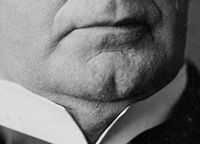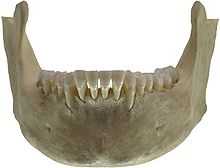Cleft chin


The terms cleft chin,[1] chin cleft,[1][2] dimple chin,[3][4] or chin dimple,[1] refer to a dimple on the chin. It is a Y-shaped fissure on the chin with an underlying bony peculiarity.[5] Specifically, the chin fissure follows the fissure in the lower jaw bone that resulted from the incomplete fusion of the left and right halves of the jaw bone, or muscle, during the embryonal and fetal development. For other individuals, it can develop over time, often because one half of the jaw is longer than the other, leading to facial asymmetry.[1]
This is an inherited trait in humans, where the dominant gene causes the cleft chin, while the recessive genotype presents without a cleft. However, it is also a classic example for variable penetrance[6] with environmental factors or a modifier gene possibly affecting the phenotypical expression of the actual genotype. Cleft chins are common among people originating from Europe.[7]
In Persian literature, the chin dimple is considered a factor of beauty, and is metaphorically referred to as "the chin pit" or "the chin well": a well in which the poor lover is fallen and trapped.[8]
See also
References
- ↑ 1.0 1.1 1.2 1.3 Mammalian Phenotype Browser:Cleft chin
- ↑ Sharks of the world, Vol. 2, pg. 143; by Leonard J. V. Compagno, Food and Agriculture Organization of the United Nations, 2001.
- ↑ Rob Roy, pg. 229 (in 1872 edition, pub. Osgood); by Sir Walter Scott, 1817.
- ↑
- ↑ Online 'Mendelian Inheritance in Man' (OMIM) 119000
- ↑ Starr, Barry. "Ask a Geneticist". Understanding Genetics. TheTech. Retrieved 2007-07-01.
- ↑ Günther, H. Anomalien und Anomaliekomplexe in der Gegend des ersten Schlundbogens. Zeitschrift für menschliche Vererbungs- und Konstitutionslehre 23: 43-52. Lebow, M.R., and P.B. Sawin. Inheritance of human facial features: a pedigree study involving length of face, prominent ears and chin cleft. Journal of Heredity 32: 127-132.
- ↑ چاه زنخدان the chin well
| ||||||||||||||||||||||||||||||||||||||||||||||||||||||||||||||||||||||